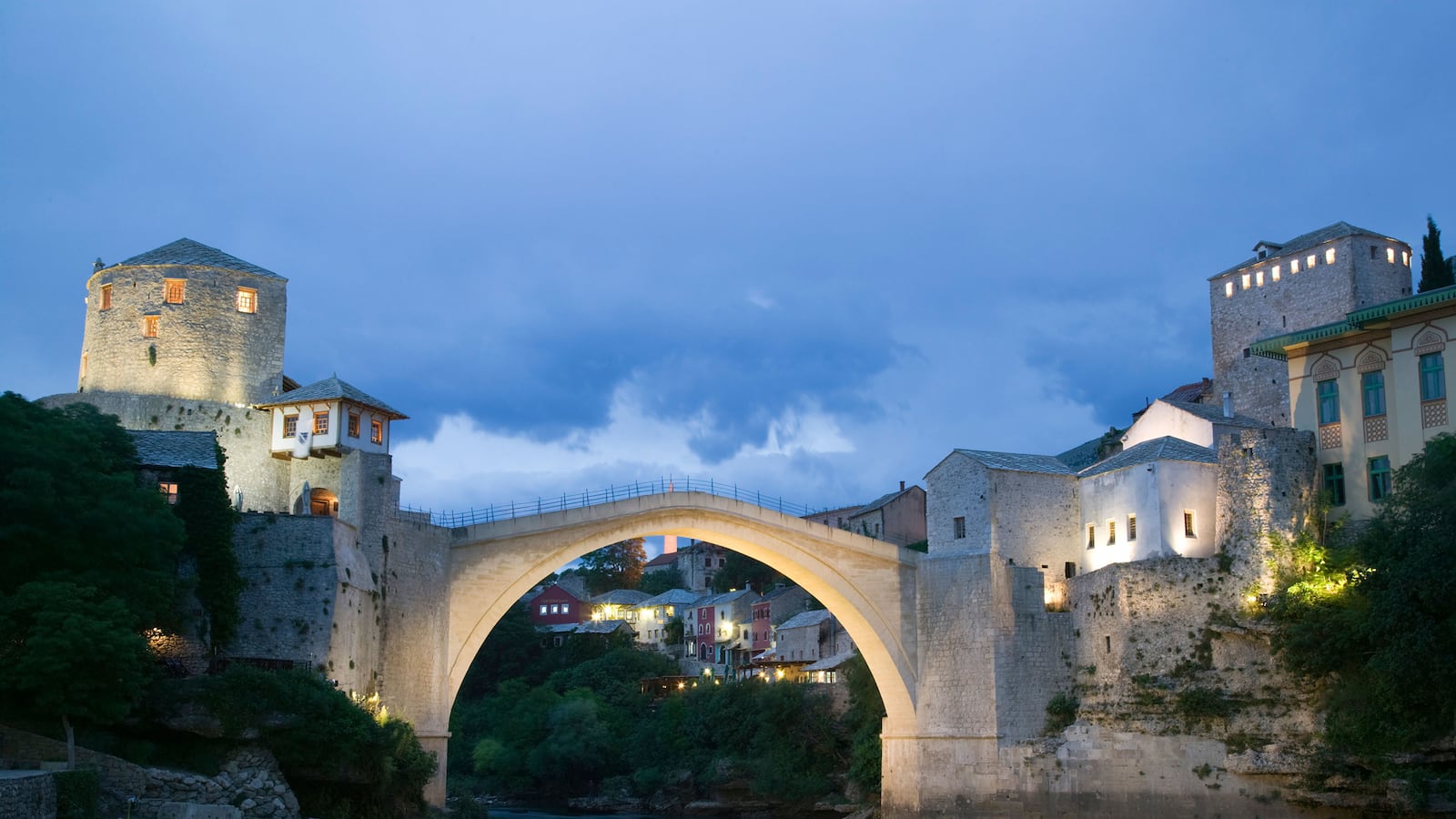MOSTAR, Bosnia — Drenched in sweat, holding onto a rock as the icy aquamarine waters of the Neretva River swirl dangerously past, I stare up at the bridge for the moment I’ve been waiting for all day: Somebody is going to jump.
The crowd yells, and in the span of three seconds one of the divers plummets 80 feet into the river below, before emerging safely.
The bridge is none other than the Stari Most, the iconic gravity-defying stone bridge whose existence spoke to the ingenuity and talent of Ottoman design and engineering, and whose destruction in 1993 came to symbolize the wanton horror of the Balkan Wars. It’s completed reconstruction in 2004 represented a new era for the region.
Looking up from the river, the bridge is a magnificent sight. It stretches nearly 100 feet from end to end. On either side are two stone gatehouses—the more memorable of the two, the western one, looms over the riverbed scene below. There, people (mostly men) of all ages cannonball off an embankment, allowing the freezing and fast-moving waters to carry them to the beach a dozen yards downstream. On a 99-degree day, the swim is worth the risk.
But the Neretva poses a danger, and not just for those jumping from the bridge. The river has a number of underwater caves, and according to one of the women running the fabulous museum and hotel, the Muslibegović Hotel, just blocks away, nearly every year somebody is drowned. Just the year before, she says, a young boy fell in while playing cards near the bank and his body was never found.
In between guardhouses soars the single arch bridge of Stari Most. The arch is topped by a slippery 13-foot-wide walkway made by an obtuse angle, giving the bridge a very distinct shape. By far the best time to view it is at night, as lights underneath illuminate the bridge, allowing it to cast a perfect reflection on the now black water rushing below.
The Stari Most connects the two sides of the central city of Mostar, a city whose entire story gets its start with the bridge. In fact, the name Mostar is derived from mostari, a Slavic word for bridge keepers. There was a wooden bridge supported by chains connecting the two banks since the Middle Ages, explains András Riedlmayer, the director of the Documentation Center for Islamic Architecture at Harvard University. But it shook so much that people allegedly got seasick or were often too scared to cross. The bridge was how one got from the Adriatic coast to the inland trade routes in the Balkans. But around the end of the 15th century, an Ottoman census put the town at a mere 30 households.
In 1557, Suleiman the Magnificent commissioned a single arch stone bridge and assigned Mimar Hayruddin to design it. Hayruddin had already cut his teeth as an engineer for new fortresses for Suleiman. Hayruddin was a pupil of Sinan, Riedlmayer tells The Daily Beast, who was “like the Michelangelo of Ottoman architecture.” He designed the incomparable Süleymaniye Mosque complex in Istanbul, as well as the Karađoz Bey Mosque down the street from the Stari Most in Mostar.
The bridge took nine years to build. Given the technical difficulty of building a free-standing single arch bridge over a raging river, legend has it that on the day the keystone was put into place, Hayruddin was preparing to be killed and made ready his shroud.
Instead, the bridge would survive earthquakes, two world wars, the Austro-Hungarian empire, and Tito’s Yugoslavia. It would see the town of a mere 30 households grow into a polyglot city of Croats, Serbs, and Bosniaks, made up of three rings of architectural styles. The inner ring is the truly enchanting time-warp Ottoman city (now a UNESCO World Heritage site) with its rambling stone houses with roofs made of shingles cut from stones. This is surrounded by both architecture from the Austrian period, in which leafy ordered boulevards are dotted with Baroque edifices (many of which are still bombed out) and concrete blocks from the Communist era.
In the 1950s, Riedlmayer tells The Daily Beast, when the new Communist town was built on the western part of the city, the old town became unfashionable and fell into disrepair. Heroic work by citizens led by Dr. Amir Pašić managed to somehow face down the bureaucratic juggernaut that is a Communist regime and pulled off an award-winning rescue and restoration of the old town.
After Pašić’s work, the old town—and the bridge in particular—became a source of civic pride. But when the civil war that tore Bosnia apart hit Mostar, the bridge became a significant target.
“It was a civic monument,” Riedlmayer explains. “But at a time of war with new nationalists—it was a symbol of Ottoman rule, so they targeted and destroyed it to demoralize the Muslim residents.
On Nov. 9, 1993, after heavy shelling by Croat forces, the bridge collapsed.
But icons like the Stari Most are rarely kept down, and once again Dr. Amir Pašić pulled off another feat. In 2004, the bridge’s reconstruction was completed.
Immediately, of course, those looking for a few seconds of thrill resumed one of the cities greatest past-times—risking life and limb to soar from the top of this magnificent piece of architectural history.






